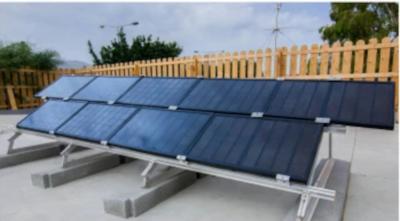An international research group, including teams from CHOSE at the University of Rome Tor Vergata, Hellenic Mediterranean University in Greece and others, has developed a large-area perovskite solar panel with graphene-doped electron transporting layers (ETLs) and functionalized molybdenum disulfide (fMoS2) buffer layers inserted between the perovskite layer and the hole transporting layer (HTL).

The team reported that with increasing temperatures, the module exhibited a smaller drop in open-circuit voltage than commercially available crystalline silicon panels.
The scientists integrated the graphene flakes into the ETL to promote the crystallization of the perovskite wrapped within the ETL itself. They said this leads to a reduction in the electron trap density, while reducing the device's dark current and improving the cell's fill factor. Poly(triaryl)amine (PTAA), which is an excellent hole- transporting and electron-blocking material, was used for the HTL.
The researchers said that at the perovskiteHTL interface, the buffer layer of fMoS2 flakes promotes the hole transfer from the absorbing layer to the HTL compared with reference devices without fMoS. In addition, they explained that the use of graphene and fMoS2 stabilizes the perovskite/ETL and perovskite/HTL interfaces, respectively, under harsh testing conditions, such as prolonged illumination and thermal stresses.
The module was fabricated with solar cells with an area of 9.1âcm2 and reached an active area of 81.9âsquare centimeters and an aperture area of 101âsquare centimeters. Its power conversion efficiency, measured under standard illumination conditions, is 12.5% and the fill factor reaches 81%.
It is expected that the power conversion efficiency spread will be reduced by a fully automated perovskite solar module fabrication, the researchers said.
The PV system is located at the campus of the Hellenic Mediterranean University (HMU) in Crete, Greece. The power generated by the facility is being stored in was stored in four serially connected 6âV vented tubular plate batteries with a capacity of 260âAh. The modules have an area of 0.5 square meters and were used to build a standalone testing field with a total area of 4.5 square meters consisting of nine panels.
The group compared the performance of the panels with that of commercially available solar modules and found that the graphene-perovskite devices exhibited the smallest drop in open-circuit voltage with increasing temperature.
The open-circuit voltage temperature coefficient of the graphene-perovskite panels is half of the one of crystalline silicon panels, simultaneously also exhibiting a larger positive short-circuit current temperature coefficient, the scientists said. At the same time, our results indicate that additional efforts are required to improve encapsulant materials and lamination protocol to extend further the panels’ lifetime.

